‘It’s so subjective’: Breakers move on from Raygun, at odds with sport judging
Raygun might be the most famous breakdancer in the world, but it seems her peers are trying to distance themselves from the controversial Aussie.
Olympics
Don't miss out on the headlines from Olympics. Followed categories will be added to My News.
Breaking is trying its best to move on from Raygun.
Two months on from the breakdancing controversy that was the talk of the Paris Olympics, the dust is starting to settle on the storm centred around Australian breaker Rachael ‘Raygun’ Gunn.
Gunn has since rubbed shoulders with Richard Branson, amassed more than 200,000 Instagram followers, been honoured with a statue in Melbourne and will no doubt be the subject of countless Halloween costumes at parties this month.
It likely won’t be the last we see of the divisive figure either after she reportedly caught the attention of the producers of Channel 10 show “I’m a Celebrity … Get Me Out Of Here!”
The 37-year-old told the Project in September: “I don’t think I’ll be competing for a while. “Not really wanting to be in the spotlight, breaking, competing.”
Debate has raged since her performance where she failed to score in any of her three battles at the Olympics.
“It is really sad to hear those criticisms,” Gunn responded. “I am very sorry for the backlash that the community has experienced.
“But I can’t control how people react.
“Unfortunately, we just need some more resources in Australia for us to have a chance to beat world champions.”
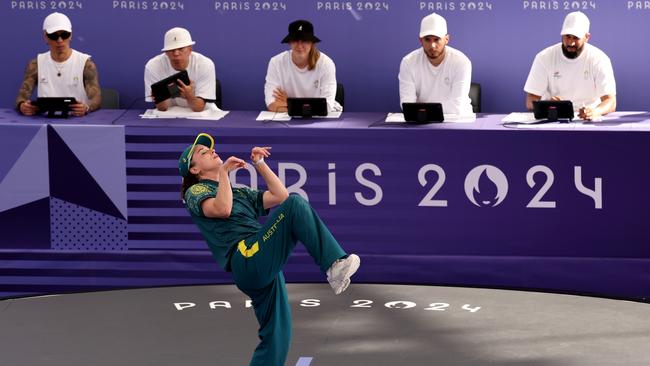
At a panel discussion at SXSW Sydney last week, the word Raygun was remarkably not uttered once in a 50-minute session titled ‘Breaking stereotypes – the rise of breaking from the streets to the main stage’.
The discussion featured American Olympian Jeffrey “B-Boy Jeffro” Louis as well as Australian breakers Gerard ‘B-Boy Kid Tek’ Cabellon and Leah ‘B-Girl Flix’ Clark.
The trio spoke about how breaking has gone from a Brooklyn hip hop craze pioneered by DJ Kool Herc, to finding itself in front of a massive mainstream audience at the Paris Olympics.
“This is the first time breaking has been on a platform like this,” Louis said.
“We don’t know what to expect. We’re the first wave of breaking being a dance sport.”
Clark said: “The lead-in to the Olympics, there was just so much more press about it.
“When those movies like You Got Served came out, it sparked a whole generation of kids coming to dance class and wanting to be in a dance crew.
“Now with the Olympics highlighting breaking as well, it’s going to spark a whole bunch of new of kids that want to start.”

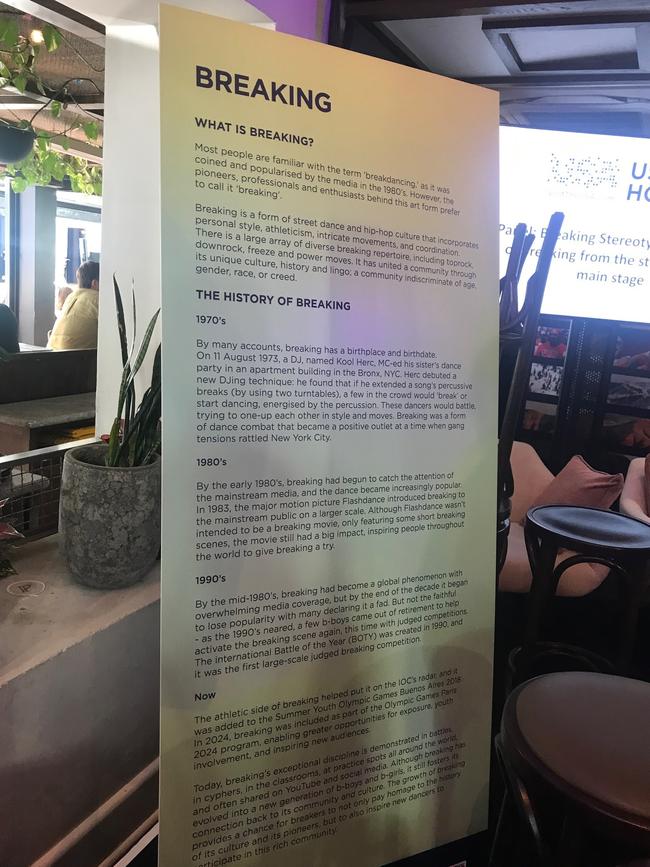
At the Olympics, the breaking battles were assessed using a five-pronged criteria — technique, vocabulary (number and variety of moves), execution, musicality and originality.
Louis said because breaking didn’t begin as a sport, breakers are still getting used to being judged so formally.
“We’re trying to find what’s the best way to judge breakers because it’s so subjective,” he said.
“If there’s two people battling, all we does is this (gesturing). We just point to the left or the right.
“Sometimes it’s not transparent enough to know why the other person won or lost or tied.
Having a judging system is new.
“There’s different things progressing in how we judge dancers. It varies between competitions. “There’s competitions and then there’s jams — we consider those two different things. Jams are more communal, the cultural side of things where you feel the energy and understand what it’s like to be a breaker.
“The competition, which is a mainstream, high budget production — that’s more for the general population.”
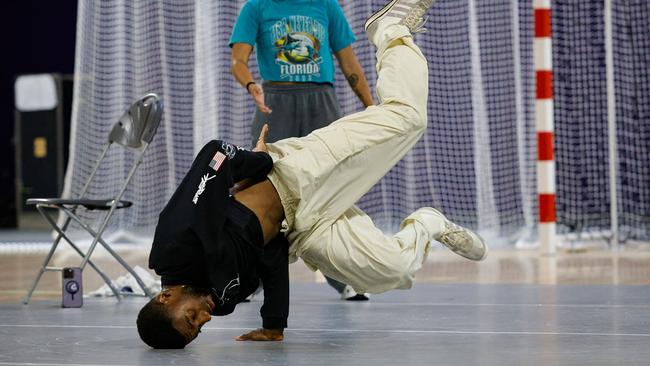
Cabellon said his speciality is “footwork” moves, which aren’t as flashy to the general public as power moves or flips.
It’s already been confirmed breaking won’t be returning for the 2028 Los Angeles Olympics, with cricket, baseball, flag football, lacrosse, squash and softball to be included.
It was decided breaking would be a one-and-done sport at the Olympics prior to the Raygun controversy.
But you get the sense from breakers themselves that the free flowing nature of breaking isn’t conducive to being judged liked gymnastics or diving.
“With other sports, you’re kind of just a spectator. But with breaking, you have a DJ so it’s like a party,” said Louis, who lost to the eventual silver medallist in the quarterfinals at the Olympics.
He described breaking as “a lifestyle — how to be creative, innovative, self motivated and have your own personal style. All of these things come from hip hop.”
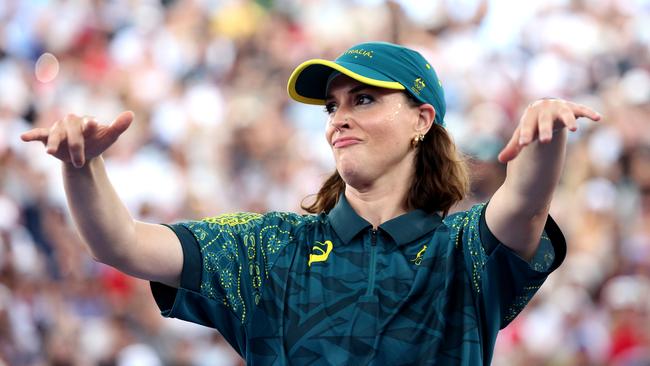
Clark said: “Breaking is a part of hip hop culture. That encompasses everything from fashion to music, the way we move and stand.”
Cabellon said: “People don’t know what to expect when they go to a breaking event.
“A basketball or soccer game, people can visualise what that looks like, how to score it, keep track of it. But with breaking, you can watch the battle but it’s a communal experience where everyone is participating.
“The crowd is making noise, the DJ’s playing music, everyone’s moving — it’s different kind of feeling to a regular sports event.”
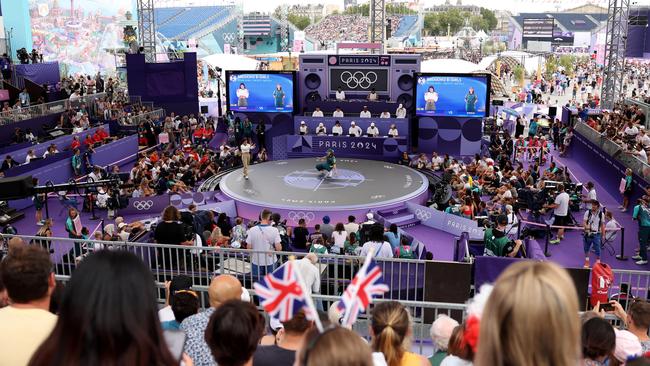
The youngster from Western Sydney said when breaking originated, “you would have a party setting where people are just vibing, music is playing”.
“People would be dancing in circles,” he said.
“You could be called out, like you’re wearing the same shoes as me but I think I look better, I’m going to call you out, let’s battle. That’s all it can take sometimes.
“For it to start like that, it’s hard to judge that. It’s hard to turn that into a quantifiable system because it started initially as just pure expression of how you felt at that moment, on that day.
“But for the Olympics, for transparency we had to create this whole system in order to break it down for the general public and competitors.”
“In Australia, a lot of us are known for being kind of wild and crazy and silly, and we’ve kind of adapted that into our breaking as well,” said Cabellon.
That sounds like a certain person who must not be named, at least on this panel.
Raygun may be ranked number one in the world, but it will take a while for Australia’s breakers to shake the Olympic controversy.
Originally published as ‘It’s so subjective’: Breakers move on from Raygun, at odds with sport judging





